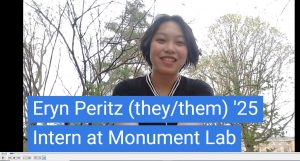Representation Matters
Semester: Spring 2023
Praxis Course: HART 420 Museum Studies Fieldwork Seminar
Faculty Advisors: Matthew Feliz & Monique Scott
Field Site: Bryn Mawr College Special Collections
Field Supervisors: Carrie Robbins & Marianne Weldon
Praxis Poster:
Final_SpencerOPraxis Poster Session
Further Context:
For this semester, I worked in the Bryn Mawr Special Collections. Specifically, I worked on creating new cataloging guidelines around artists’ demographic information. This includes such information as race, ethnicity, and gender. Before this semester, there were no consistent guidelines for how to put this information in the collection database. My final product for the semester is in fact a proposal for these new guidelines. I created these guidelines in collaboration with another intern, Graziella. The two of us spent a lot of time considering language. What language should be used to talk about race? Where should this language be used? These are difficult questions that do not have a good answer.
To start the semester off, we began by looking at how other institutions catalogue this data. We collected the information in order to try and understand the industry standard. Once we had finished this process, we began looking inward. This included looking at the efforts around cataloging diversity in the collections. We also did work to understand what was possible with Embarke, the college collection management software. Once this process was done, we could begin work on drafting our recommendations. Our recommendations include suggestions such as where to display the information about an artist’s demographics, how to determine the appropriate language for describing artist demographics, and how to determine an artist’s demographic information. When the recommendations were done, we began testing them on some of the artists in the collection. Based on that, we refined our suggestions.

